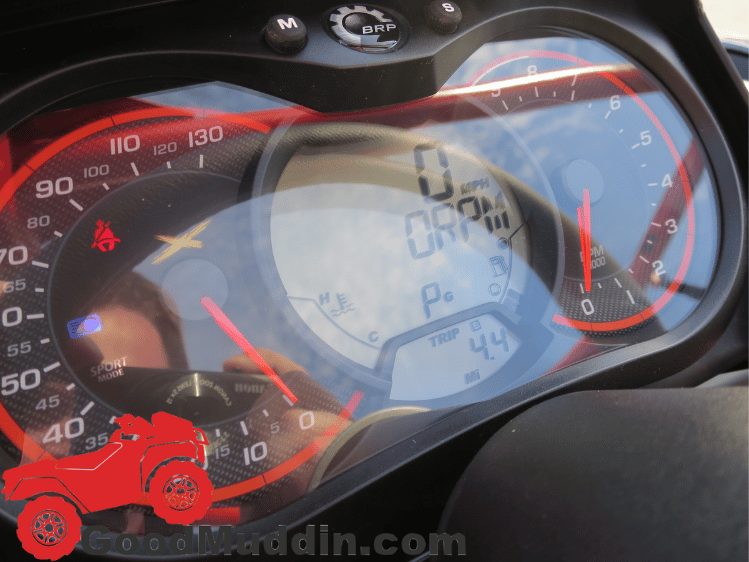I say keep it nearly empty.
If you’re storing your ATV for a long time, it’s better to leave just a little bit of gas in the tank – not too much, about a quarter tank.
Let’s look at why keeping your tank mostly empty is a good idea:
- Fuel goes bad over time. By storing less, you’ll waste less when it’s time to toss the old stuff out.
- Wasting fuel means wasting money. It’s pricey, so don’t let it just sit and rot.
- Gas tanks aren’t perfect. They can leak some out, so the more you have, the more you might lose.
- Old fuel can gum up and mess up your tank. The more you store, the worse it gets.
- When you’re ready to ride, just add some premium to freshen things up.
- New engines are super sensitive to gas quality because of regulations. Even slightly bad gas can trigger warnings. So, store less to avoid these issues.
- Most gas now has ethanol, which can attract water. This can be a problem in bigger quantities. Plus, there are talks about adding even more ethanol to gas, which can make storage even trickier.
Why Do They Say A Full Tank?
In this modern time, given all the ethanol in gasoline, it’s wiser to keep your tank mostly empty for long-term storage.
You may have heard recommendations that fuel tanks should be stored full. This is suggested to avoid water entering the tank and contaminating the fuel. However, this idea has its flaws. A fuller tank means a greater potential for water accumulation. Gas tanks are not completely airtight; they vent, allowing water to gradually infiltrate over time.
It’s smarter to assume that water will enter, and the gas will degrade, so storing less of it is the way to go.
In the past, certain components like fuel lines and pumps needed to be in contact with fuel, or they’d degrade. But today’s advanced materials are sturdier and don’t always need this contact from rotting. Moreover, many modern machines use electric components for fuel delivery, relying more on grease and bearings than on the fuel itself.
Fuel Lifespan
Fuel can stay good for 3 to 6 months without any additives. But with a fuel stabilizer mixed in, you can extend its lifespan to between 6 months and a year.
Many folks underestimate how quickly gasoline can go bad, often neglecting proper storage for extended periods. And the situation’s getting worse with the increasing ethanol content in gasoline nowadays.
If you’re facing any start-up or performance issues, a good first step is to swap out that old fuel for a fresh gas. Old gasoline will keep an engine from starting or running at its best performance. It’s surprising how often this simple fix works, especially for ATVs that have been parked for a while.
How To Know Gas Is Bad
There are several signs that give away that the gas is bad, here are some of them:
- Smell: Fresh gasoline has a familiar petroleum smell. If the gasoline smells sour, rancid, or stale, it’s likely that it has gone bad.
- Appearance: Pour a little gas into a clear container and inspect it. Fresh gas is relatively clear. If the gasoline looks dark, murky, or has any particles floating in it, it may be bad.
- Phase Separation: This mainly applies to gasoline with ethanol (like E10). Over time, ethanol can absorb water, which can cause it to separate from the gasoline. If you see distinct layers in the gasoline (a clear layer and a cloudy layer), this indicates phase separation.
- Performance Issues: If your engine has trouble starting, runs rough, stalls, or experiences a loss in power, old or bad gasoline might be the culprit.
- Poor Fuel Economy: Degraded gasoline will result in reduced miles per gallon, causing you to refuel more often than usual.
- Check Engine Light: Degraded fuel can cause the check engine light to come on. Though there can be many reasons for this light, if you suspect fuel issues, it’s worth considering.
In all honesty, if you think the fuel is bad, either remove it or add premium gas to the tank. This is especially true if the fuel is old, over 6 months old, just replace it.
How To Remove Fuel From Tank
The best way to remove old fuel from your fuel tank is by using a fuel transfer pump.
You can get a battery-powered fuel transfer pump (ad) that will work very well to remove the bad fuel. Just make sure you have a proper container to put the bad stuff in.
You can use the bad fuel in lawn mowers and other small engines, as they’re not as picky. Avoid putting it in your car as it can cause issues.
Fuel Pump Damage
A lot of folks are hesitant to keep their tank close to empty, thinking it might harm the fuel pump.
While it’s true that the fuel pump needs some gas to prevent it from overheating or getting damaged, it doesn’t require a full tank. As long as there’s a bit of gas, the pump should be fine.
Actually, when ATVs leave the factory, they’re filled with just a little bit of gas – about 1/8th of the tank or slightly below a quarter. That’s just enough to keep the fuel pump in good condition. So, if you maintain around this level in your tank, your machine will be okay.
Personally, I prefer to leave it at about a quarter tank. Given that most tanks hold around 5 gallons, that’s roughly 1 gallon of gas. I reckon it’s smarter to potentially waste 1 gallon than to risk wasting all 5 when it’s time to ride again next season.
